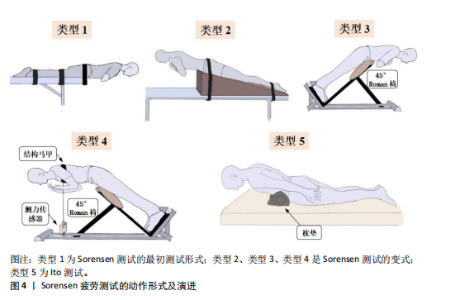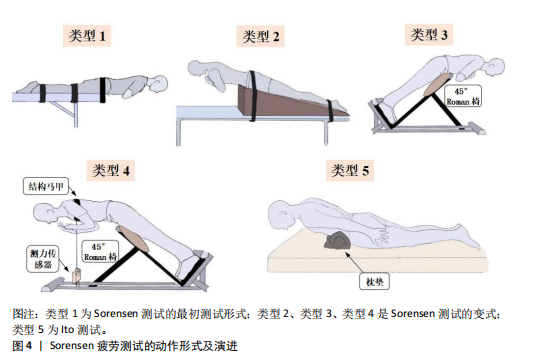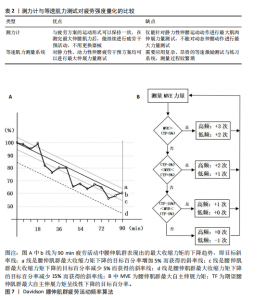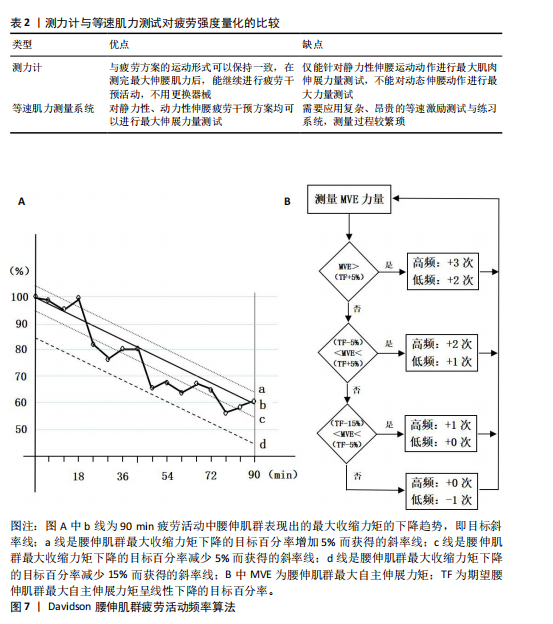Chinese Journal of Tissue Engineering Research ›› 2026, Vol. 30 ›› Issue (10): 2515-2524.doi: 10.12307/2026.608
Previous Articles Next Articles
Fatigue induction protocols for the lumbar extensor muscles
Xing Cong
- Department of Physical Education, Fudan University, Shanghai 200433, China
-
Received:2025-03-10Accepted:2025-05-30Online:2026-04-08Published:2025-08-29 -
About author:Xing Cong, PhD, Lecturer, Department of Physical Education, Fudan University, Shanghai 200433, China -
Supported by:the Youth Fund for Humanities and Social Sciences Research of the Ministry of Education, No. 20YJC890031 (to XC)
CLC Number:
Cite this article
Xing Cong . Fatigue induction protocols for the lumbar extensor muscles[J]. Chinese Journal of Tissue Engineering Research, 2026, 30(10): 2515-2524.
share this article
Add to citation manager EndNote|Reference Manager|ProCite|BibTeX|RefWorks
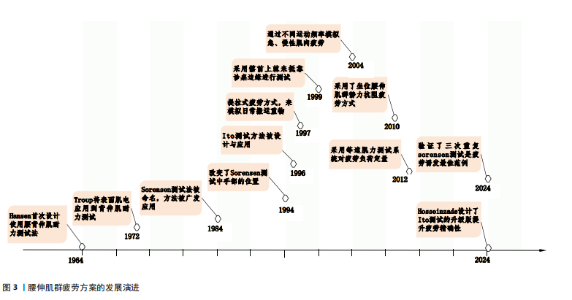
腰伸肌群疲劳方案自1964年首次由Hansen设计用于腰背肌肉耐力测试,至今已有60多年历史。腰伸肌群疲劳诱发方案发展的重要内容与时间节点如图3所示,发现腰伸肌群疲劳方案的发展演进主要围绕“疲劳动作形式的改进”“疲劳运动负荷设计”“疲劳状态评价与定量”“疲劳方案有效性与精确性提升”等研究方向,且1995-2012年间疲劳方案重要研究节点最为密集。 2.1 实验室模拟腰伸肌群疲劳的运动性疲劳属性 以往多以“机体的生理过程不能持续其功能在某一特定水平上和各器官不能维持预定的运动强度”来定义运动疲劳。这一定义主要从完成机体任务或机体功能表现方面来评判运动疲劳,但它忽略了运动疲劳引起的人体认知功能的变化[16]。肌肉输出力量与功率等功能表现作为运动疲劳的特征容易被测得,但与疲劳相关的“人体感知水平”是否发生了改变则较难确定[17]。根据运动疲劳的生理表现和人体感知功能变化,ENOKA等[18]将运动疲劳定义为:功能表现性疲劳和感知性疲劳交互作用下,人体生理功能和认知功能受到限制的功能损失症状。 在日常生活中,运动导致的腰伸肌群疲劳主要是竖脊肌腰段和腰方肌这些局部肌群产生力量和功率的能力下降[19],这是疲劳刺激引起人体肌肉功能障碍的现象,属于表现性疲劳范畴,与人体心理及认知能力变化无关。导致表现性疲劳的因素通常分为两类:涉及中枢神经系统和神经通路的中枢因素,以及发生在肌肉内环境的外周因素[20-21]。外周因素主要发生在神经-肌肉间冲动的传递过程,包括神经冲动在肌纤维膜上的传导、钙离子释放、代谢产物的产生及积累、横桥与运动蛋白的交互作用等。中枢因素主要是由身体活动引起的中枢神经系统对肌肉激活及驱动的能力下降[22]。外周因素引起的是肌纤维本身产生力量和输出功率能力的下降,而中枢因素是中枢神经系统对肌纤维运动单位募集能力的下降。虽然中枢因素也会导致肌纤维输出功率下降,但其本质与肌纤维本身产生力量的能力无关[23]。中枢神经系统疲劳引起的肌肉自主激活能力下降,不仅针对特定的几个肌肉或肌群,还可能会导致全身肌肉输出力量普遍下降[24]。而身体活动引起的腰伸肌群疲劳现象,如持续鞭打运动或搬运重物,显然是由于腰伸肌群持续收缩,使肌肉内环境发生改变导致的肌纤维自身输出功率下降。因此,实验室中模拟的腰伸肌群疲劳应属于表现性疲劳的外周疲劳现象。 2.2 腰伸肌群疲劳活动的动作形式 腰伸肌群疲劳方案属于局部肌肉疲劳方案,应尽可能在不引起人体各运动环节中无关肌肉疲劳的前提下使腰伸肌群产生疲劳。腰伸肌群疲劳方案常用的两种动作形式:腰伸肌群等长静力收缩克服固定阻力或腰椎在一定活动范围内做伸腰运动以克服阻力。应用上述两种疲劳动作形式的优点是:腰伸肌群疲劳方案使用简便,不需要设计过多的活动动作;人体运动的幅度不大且有利于动作控制;受试者承受的全身负荷较小;缺点是:腰伸肌群活动的频率及节奏与专项运动有较大的差异,疲劳活动负荷难以与专项运动时所达到的负荷完全一致,从而影响疲劳效率。使用较为广泛的腰伸肌群疲劳动作方案主要有3种,即Sorensen腰伸肌群疲劳活动、坐位伸腰抗阻活动、站位伸腰提拉抗阻活动。以上3种活动形式也用于辅助测量下腰背肌肉耐力以及提高腰背肌力量[25-27]。 2.2.1 Sorensen腰伸肌群疲劳活动 如图3中,Sorensen测试法由Hansen"

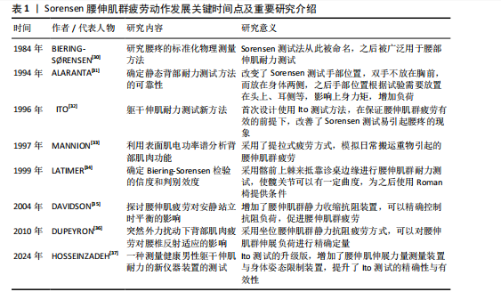
在1964年首次设计并应用,它是使受试者腰伸肌群持续静力收缩对抗重力来测量腰伸肌群耐力的一种方法[28]。此方法用于测量腰伸肌群耐力[29],一直沿用至今。1984年,Biering-Sorensen将这一测试方法发表在《Spine》杂志[30],从此这一测量方法被称为Sorensen测试。由于 Sorensen测试可以使腰伸肌群肌电中值频率及平均频率明显下降,因此,这一活动形式广泛应用于诱发腰伸肌群疲劳。表1是Sorensen腰伸肌群疲劳动作发展关键时间点及重要研究介绍[30-37]。图4是Sorensen疲劳活动动作形式的演化。 图4中的类型1是最初Sorensen测试的动作形态,这一形态被延用至今。图4中各动作形式均描画自近年文献的疲劳方案[35,38-40]。Sorensen测试要求受试者俯卧于诊桌、诊床或斜面上(如图4中类型2),髂嵴上缘与诊桌边缘平齐,使上身探出诊桌悬空。下肢由3条扁带,分别从骨盆、膝关节、踝关节三处固定于诊桌之上。双臂交叉于胸前,并要求受试者躯干与下肢保持直立状态[39]。Sorensen测试的动作形式可以有效引起腰伸肌群疲劳。但有许多研究者指出,在这一方案中髋关节伸肌作为协同肌也参与了伸腰运动,髋关节伸肌耐力水平也有助于腰伸肌群的耐力表现[41-42]。同时Sorensen测试的动作姿势不适合某些特殊受试者,例如老年人、腰部疼痛或无力的个体等。 经过多年的实践,现在多采用髂前上棘抵靠诊桌边缘[43],这一改变使受试者在髋关节处产生一定角度的弯曲,如图4的类型3,4,之后的测试中有很多受试者使用髋关节处弯曲的姿势,弯曲多达40°[44]。髋关节屈曲可以缓解下肢伸肌肌群在测试中的紧张程度,避免造成除腰伸肌群以外的肌肉过度疲劳。下肢固定设备也从诊桌转变为Roman椅,这样可以取消固定用的扁带,使试验更加方便。此外在大多数使用Roman椅的Sorensen测试中观察到受试者有较长的保持时间和较低的肌肉费力感受,"

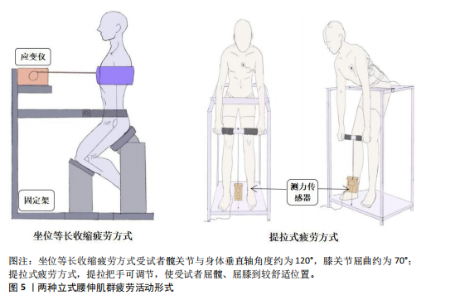
说明Roman椅式测试方式对老人等特殊测试者更加适用,可以作为标准测试的替代方法[45]。 手臂放置的位置也根据试验目的的不同发生变化,主要将手放于耳上[46]、额前[47]、颈部[48]、胸前交叉[49],部分方案中将手臂放于身体两侧[50]。由于手臂位置影响身体重心位置,这些修改会影响上身力矩,进而影响疲劳效果。此外,部分方案使受试者胸前戴上结构马甲,马甲连接地面拉力传感器[40],如图4类型4。这种结构既可以增加腰伸肌群用力负荷,又能较精确地控制腰伸肌群力量输出。 此外,虽然Sorensen测试具有较高的测试者信度,但由于脊柱疼痛或腿部、腹部疼痛而停止测试是Sorensen测试的一个重要缺点[34]。1996年,Ito描述了一种评估下背部肌肉耐力的替代测试方法,被称为Ito测试。如图4类型5。受试者俯卧,腹部下垫枕垫,双臂在两侧。在测试中,受试者将胸骨从检查台上抬起,同时尽可能弯曲颈部并收缩臀大肌以稳定骨盆[32]。最大颈部屈曲和臀肌收缩是减少腰椎前凸和最大限度激活腰竖脊肌的最佳姿势。与Sorensen测试相比,Ito测试也很容易执行且它的重测信度非常高,同时不会引起任何疼痛[51-52]。 疲劳方案开始时,普遍采用上身放松向地面倾斜的起始位。在开始的口令下达后,躯干为达到与地面水平的位置,必须使腰伸肌群收缩,达到伸腰的目的,这种身体姿态避免了躯干屈曲肌肉的参与。为保证腰伸肌群疲劳效果,部分静力性运动方案中会在受试者后背放置水平仪,当检测到上半身倾斜超过10°,或者观察到受试者的肩膀/头部高于或低于骨盆的水平位置时,会提醒受试者回到最初状态,直至达到方案要求的时长[43,53]。 2.2.2 坐位伸腰抗阻活动及站位伸腰提拉抗阻活动 与Sorensen疲劳活动形式不同,坐位与提拉式疲劳活动方案中,受试者身体姿态不再是俯卧位,而是身体竖立,如图5[36,54]。 (1)坐位腰伸肌群疲劳方式:坐位腰伸肌群等长收缩疲劳方式与Sorensen测试较为相似,不同的是这一方法采用坐位,并人为设置伸腰负荷,如图5。大致要求如下:受试者坐在一个特定的木制装置上,髋关节屈曲至120°,膝关节屈曲至70°,身体整体伸展180°;扁带经过髂前上棘固定住骨盆,主要目的是为了限制骨盆及髋关节运动,形成一个脊柱与髋关节弹性平衡的中立躯干位[55];受试者上身穿一件特制的马甲,马甲连接一个应变测力计,连接线与受试者第10胸椎平齐,这一装置可以测量腰伸肌群最大自主收缩所产生的力量,并可以提供持续固定强度的伸腰阻力来使受试者疲劳。 这种坐位腰伸肌群疲劳方法通过限制下肢及骨盆,可以较准确地引起腰伸肌群的疲劳。但这一方案需要的辅助器械较多,固定较复杂;另外,由于上身固定的缘故,躯干伸肌只能进行等长耐力收缩活动,这样难以模拟腰部伸展活动所产生的肌肉疲劳[36]。 (2)提拉式腰伸肌群疲劳方式:在日常生活及工作中,经常有搬运重物造成腰伸肌群疲劳的现象。为模拟这一类腰伸肌群疲劳,试验研究中引入了提拉式腰伸肌群疲劳方案,如图5中提拉式疲劳方式。身体姿势要求:受试者站在特制的木制框架中,身体被捆绑于中间横木上;骨盆前沿及大腿靠在横木上,在木框中身体呈微屈膝、屈髋且前倾姿态;同时要求受试者向上拉把手,两把手连接地面上固定的测力计,由于把手受框架约束,使其仅能在垂直方向上移动;把手的高低可以调节,使受试者腰椎在60%-70%范围内屈伸。这一结构设计较为精密,既可以模拟日常提拉活动产生的疲劳,又可以精确控制伸腰提拉时产生的力量。 有研究将这一测量方案与Sorensen腰伸肌群疲劳方案进行比较,发现在腰伸肌群以持续固定负荷等长收缩的活动方式中,Sorensen测试姿势与提拉式疲劳测试姿势的竖脊肌腰段肌电中值频率下降程度均与动作持续时间高度相关[56]。但在以腰椎伸展为主要动作的Sorensen测试中,竖脊肌腰段肌电中值频率下降程度与持续时间的相关性相比于提拉动作更加明显,疲劳效果更好。Sorensen动作相比于提拉式动作更容易使腰伸肌群疲劳,主要是Sorensen俯卧姿势中,腰背筋膜、脊柱间韧带、椎间盘本身等这类无法主动发力组织的支撑更少,造成背部肌肉相对于提拉式动作的站立姿势承担更大的伸展力矩。此外,在次最大强度的提拉任务中,肩、手臂、腿的肌纤维有助于稳定身体,也就是说这些部位的肌肉会承受比腰伸肌群更大的负荷,这些肌肉很可能比腰伸肌群更早疲劳,导致在腰伸肌群疲劳前受试者提前终止任务,进而影响腰伸肌群的疲劳效果。 2.3 腰伸肌群疲劳活动负荷 2.3.1 腰伸肌群疲劳活动强度的量化 利用腰伸肌群最大自主收缩时产生的力量来量化疲劳活动中腰伸肌群所承受的活动强度。在腰伸肌群疲劳活动前测量受试者腰伸肌群最大自主收缩/伸展(maximal voluntary contractions/exertion,MVC或MVE)力量或力矩。腰伸肌群以最大强度进行疲劳活动时对应接近100% MVC力矩或力量的抗阻活动;腰伸肌群以次最大强度进行疲劳活动时,则对应约为80% MVC力矩或力量的抗阻活动;腰伸肌群以中、大强度进行疲劳活动时,则对应为60%-70% MVC力矩或力量的抗阻活动。 测量腰伸肌群MVC/MVE力量,可通过测力计或多关节等速肌力测试及训练系统来完成。利用测力计测量时可设置如图5中坐位方案中的测力计装置,相同的测量方法也可以在Sorensen卧姿方案中应用,如图4中的类型4。测量时受试者尽全力伸腰从而牵引测力计,持续10-20 s。一般测量3组,组间安排充分休息,取最大值作为MVC值。利用多关节"
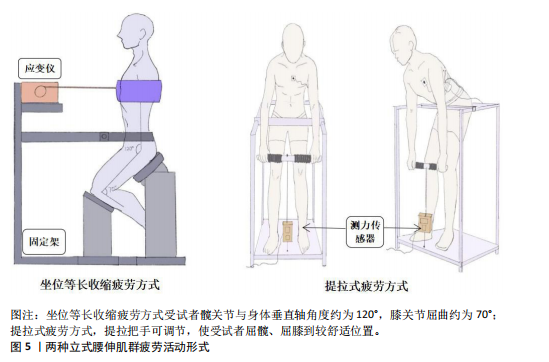
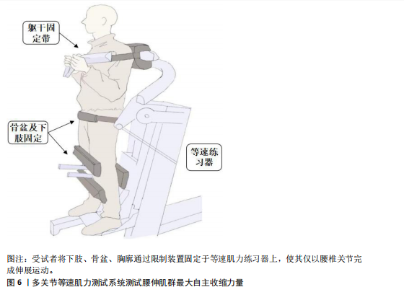
等速肌力测试及训练系统(Con-Trex)来测量腰伸肌群MVC力量及力矩时,受试者需将胸、髋、膝、踝等关节进行固定,如图6所示[57]。测量时使受试者腰椎向前弯曲一定的角度,之后尽全力进行伸腰运动,对等速肌力测试系统施加最大力量,弯腰则不施加力量,持续10-20 s,从而获得腰伸肌群MVC力量或力矩。测力计与等速肌力测试对疲劳运动方案强度量化的优缺点比较如表2所示。 2.3.2 腰伸肌群疲劳活动量与强度设计的关系 在日常生活或运动训练中,有短时间、高活动密度伸腰抗阻活动,即高频疲劳[58];也有长时间、中低活动密度伸腰抗阻活动,即低频疲劳[59]。那么在制定疲劳方案时应该如何模拟上述两种不同疲劳形式?DAVIDSON等[35]在一段固定时长(腰伸肌长时间低频活动或短时间高频活动)内,使用图4中类型3的腰伸肌群疲劳活动形式,通过比较腰伸肌群MVC力量的实际下降值与期望下降值之间的差值,设计出一套确定伸腰活动频率的算法。这套算法为疲劳方案中腰伸肌群活动量与活动强度的制定提供了依据,使腰伸肌群更合理且更有效地达到疲劳状态。 为达到高频或低频腰伸肌群疲劳,Davidson设计使受试者俯卧于Roman椅上,在固定时限内,每分钟完成一定数量(这一数量由图7中算法获得)的伸腰运动。这一过程中,高频疲劳活动每2 min,低频疲劳活动每6 min测量一次实时腰伸肌群的MVC力量值,期望通过10 min或90 min的活动,使腰伸肌群MVC力量值呈现出线性下降现象,最终下降到未疲劳时的60%MVC力量值及以下。通过实时腰伸肌群MVE百分率与腰伸肌群MVE力量呈线性下降的目标百分率(target force,TF)来系统调节每分钟伸腰运动的数量。主要计算方法如图7所示。 图7是通过实时MVC百分率与目标MVC百分率的差值,来计算每分钟受试者所要完成伸腰运动次数的算法。实时MVC百分率是实时MVC"
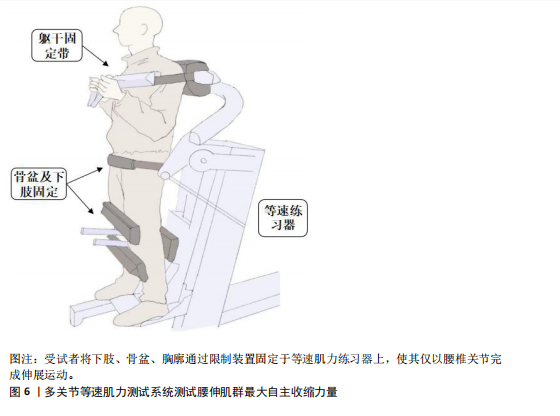
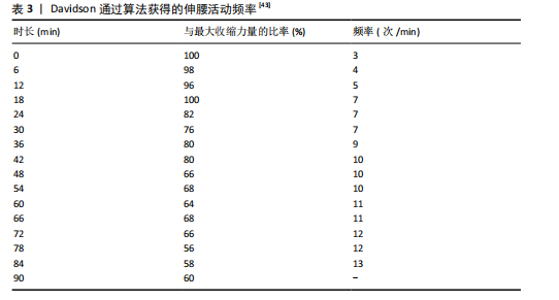
值除以未疲劳时MVC值所得的百分率。图7A是腰伸肌群低频疲劳时,即90 min疲劳活动过程中,比较腰伸肌群实时MVC下降百分率与所期望的目标下降百分率的差别。其中,b线即直实线,是90 min疲劳活动中期望腰伸肌群表现出的MVC百分率下降趋势;a线和c线即浅色实线,是目标MVC百分率±5%所得到线,即TF+5%与TF-5%;d线即点状虚线,是目标MVC百分率-15%所得的线,即TF-15%;最后,折线实线是实际每6 min测得的实时MVC百分率。根据b线两点(0,100)、(90,60),可以求出期望值b线所对应的函数f(x)=-2/3x+100。当第6分钟测得实时MVC百分率为98%,而6 min时目标MVC百分率为-2/3*6+100=96(%),则实时MVC百分率介于a线和c线之间,即小于TF+5%,大于TF-5%。根据图7B算法,低频率疲劳活动时每分钟要增加1次伸腰运动,即在下一轮的 6 min练习中,每分钟伸腰运动次数在原来基础上增加一次。Davidson通过以上算法获得的伸腰运动频率与时间的关系如表3所示。 表3是Davidson设计的90 min低频率伸腰活动使腰伸肌群疲劳过程中,每个6 min时段内对应的伸腰运动频率。每6 min测量一次腰伸肌MVE力矩,并换算成相对最初MVE的百分率。第1个6 min,规定受试者每分钟完成3次伸腰运动,完成后测得受试者MVE相对百分率为98%。根据上文算法,在接下来的低频率伸腰动作中,每分钟伸腰动作增加1次。在第2个6 min中,即6-12 min时段内,受试者伸腰活动频率为每分钟4次。以此类推,若疲劳活动最后测得腰伸肌群MVE力量没有下降到未疲劳时的60%及以下,则增加2 min的额外疲劳活动,伸腰运动的频率依然按照上述算法执行。这一算法使腰伸肌群疲劳方案中疲劳活动时长与强度的设定有了参考依据。此后,腰伸肌群疲劳研究所使用的疲劳方案多以此算法为依据,来确定腰伸肌群疲劳活动的负荷强度。"
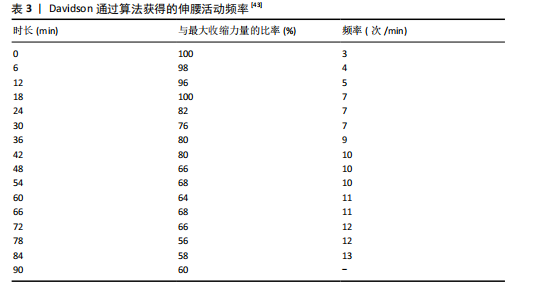

2.4 腰伸肌群疲劳状态判定 多数研究表明,只要开始运动,人体就会随之产生疲劳。但是这一现象难以被量化。因此,如何在腰伸肌群疲劳方案中反映肌肉疲劳情况,精确判定肌肉疲劳程度,也是腰伸肌群疲劳方案研究的重点。 2.4.1 借助肌电功率频率谱来判定腰伸肌群疲劳状态 1972年,TROUP等[60]首次将表面肌电技术融入到腰背伸肌耐力测试中。近些年肌肉疲劳多通过肌电功率谱来分析,计算肌电中值频率随时间的下降率及肌电振幅随时间的增加来证明肌肉产生了疲 劳[3]。由于在肌肉疲劳收缩时,肌电功率频率谱会向更低的频率偏移,因此,对中值频率和平均频率的分析可以评估这一变化的幅度,这是因为疲劳引发的肌电频谱指标下降与动作电位传导速度有关。新陈代谢副产物积累,影响动作电位传导速度进而导致肌电中值频率及平均频率下降。在肌肉持续等长收缩过程中,肌电中值频率及平均频率是测量肌电功率谱向低频率偏移最合适的参数,主要因为中值频率及平均频率对噪声不敏感,而对于与肌肉疲劳相关的生理变化更敏感(尤其是动作电位传导速度下降)[61]。但这些现象仅在恒定负荷下的肌肉等长收缩中被确认,在其他肌肉收缩形式中这一现象尚不明确。此外,在肌肉疲劳收缩时,肌电振幅随时间的增加也可以证明肌肉产生疲劳现象。肌电平均振幅趋势反映所测量的肌肉内运动单位的募集情况,在典型的次最大强度疲劳试验中,肌肉运动单位募集增加,肌电振幅平均值也增加。 在腰伸肌群疲劳诱发方案中,记录肌电中值频率时序变化的具体方法如下:在相当一段时长的腰伸肌群等长收缩活动中,取固定截距时长,计算每个截距的肌电中值频率及肌电振幅[62-63]。常用最小二乘线性回归来计算肌电中值频率及肌电振幅随时间变化的斜率。若肌电中值频率随时间变化的斜率为负值,肌电振幅随时间变化的斜率为正值,则可以说明腰伸肌群在疲劳活动中产生了疲劳的趋势。 2.4.2 借助腰伸肌群最大自主收缩力量的下降程度来判定腰伸肌群疲劳 肌肉输出力量不能维持在一个稳定的强度被视为肌肉疲劳,因此肌肉收缩力量或关节力矩明显下降可以直接表明肌肉产生了疲劳。在腰伸肌群疲劳方案中,腰伸肌群输出力量或产生关节力矩的下降程度成为判定腰伸肌群是否达到疲劳,以及疲劳方案是否停止的重要标志。通过测量疲劳方案实施前后的腰伸肌群MVC力量或力矩值并进行对比,获得疲劳活动后相对于疲劳活动前腰伸肌群MVC力量或力矩值的比例。一般将腰伸肌群疲劳活动后MVC值下降到正常状态下的60%-80%,作为达到腰伸肌群产生明显疲劳的标志,意味着腰伸肌群疲劳模拟完成,可以终止疲劳方案。表4"


是肌电功率频率谱以及肌群最大自主收缩力量的下降程度,通过两种方法的比较可以发现,腰伸肌群疲劳的判定可以应用肌电功率谱进行肌肉疲劳过程分析,结合MVC力量下降的百分率进行综合评价。 2.5 影响腰伸肌群疲劳效果的因素分析 2.5.1 受试者个体差异对腰伸肌群疲劳方案的影响 研究普遍认为,腰伸肌群的易疲劳性存在性别差异。研究者通过肌电图信号频谱来分析男女受试者在Sorensen测试中的表现,发现女性保持腰伸肌群等长收缩的时间比男性更长,且腰伸肌群肌电中值频率的下降程度比男性更小[33],这说明男性在Sorensen测试中更易疲劳。这种现象的原因多被认为是女性相比于男性上身质量更小、躯干重心更低,且女性腰椎更加前凸,可以延长脊柱肌肉的杠杆臂,从而获得力学优势[64]。 在腰伸肌群抗阻诱发疲劳的方案中,有研究利用“线性回归”来分析腰伸肌群肌电中值频率的下降率,结果发现肌电中值频率的下降率取决于受试者体质量指数,且这一现象在男女受试者中普遍存在,但男性受体质量指数影响比女性稍小[65]。体质量较重的女性比体质量较轻的女性竖脊肌及多裂肌的肌电中值频率下降率更大[66],说明体质量较重的受试者更容易诱发腰伸肌群疲劳。研究还发现,腰伸肌群疲劳方案受年龄的影响也较为明显。在Sorensen疲劳方案中,受试者竖脊肌及多裂肌肌电中值频率的下降率表现出与年龄高度相关,年轻受试者比年长受试者竖脊肌疲劳更快[28]。综上所述,在使用Sorensen测试法诱发疲劳及比较疲劳程度时,应该充分考虑性别、年龄、体质量指数的影响,控制这些因素对试验结果的负面影响。 2.5.2 人体运动环节的链状特性对疲劳方案的影响 由于任何动作都是在多个人体环节之间的相互作用下完成的,各环节之间的结构及功能存在相互替代和补偿的链状特性[67],这就造成在腰伸肌群疲劳方案中伸展背部和髋关节的肌肉也会参与其中,会附带引起邻近环节肌肉的疲劳。在对Sorensen疲劳方案的研究中发现,疲劳活动在引发竖脊肌、多裂肌疲劳的同时,也导致髋关节周围肌肉肌电中值频率明显下降,例如股二头肌、臀大肌等[68]。在研究腰伸肌群疲劳后的人体动作结构或基本运动功能时,这些除腰伸肌群以外的次要肌肉疲劳可能会对测量结果产生影响,且这一影响无法通过统计手段剔除。需要指出的是,虽然腰伸肌群疲劳方案无法做到使单一腰伸肌群疲劳,但腰伸肌群作为伸腰的主要肌肉在疲劳活动中获得充分负荷且达到了疲劳要求;而其他肌肉作为疲劳活动的次要肌肉其疲劳程度必然远低于腰伸肌群。腰伸肌群疲劳方案得到广泛的应用也说明了这一方案在疲劳研究领域的价值。"

| [1] ADAMOVÁ B. Assessment of Lumbar Extensor Muscles in the Context of Trunk Function, a Pilot Study in Healthy Individuals. Appl Sci. 2021;11(20):9518. [2] PADWAL J, BERRY DB, HUBBARD JC, et al. Regional differences between superficial and deep lumbar multifidus in patients with chronic lumbar spine pathology. BMC Musculoskelet Disord. 2020;21(1):764. [3] ZSOY G, SZEN H, SOYLU AR. The effect of trunk extensors and abdominal muscle fatigue on static and dynamic balance. Kinesiol Sloven. 2022;28(3):136-153. [4] KIRMIZI M, YALÇINKAYA ÇOLAK G, SALIK ŞENGÜL Y, et al. Investigation of trunk muscle endurance and standing balance according to severity of disability in women with moderate to severe disability due to neck pain. Agri. 2024;36(4):248-256. [5] STEELE J, FISHER J, PERRIN C, et al. Does change in isolated lumbar extensor muscle function correlate with good clinical outcome? A secondary analysis of data on change in isolated lumbar extension strength, pain, and disability in chronic low back pain. Disabil Rehabil. 2019;41(11):1287-1295. [6] VLAZNA D, ADAMOVA B, KRKOSKA P, et al. Strength and endurance of the lumbar extensor muscles and their predictors: A cross-sectional study in healthy subjects. J Electromyogr Kinesiol. 2025;80:102973. [7] ANSARI S, SHARMA S. Does multifidus muscle fatigue asymmetry exist in athletes with chronic low back pain. Sport Sci Hlth. 2024;20(2):449-454. [8] SANTOS PJ, ARAGÃO-SANTOS JC, CARVALHO EÁN, et al. Functional vs. dual-task training effects on trunk muscle function and functional fitness in older women with and without chronic low back pain: A randomized clinical trial. Gait Posture. 2024;114:35-41. [9] ESFAHANI NH, DOMMERHOLT J, REZAEIAN Z. Core Muscles Endurance in Sedentary Staffs with and without Nonspecific Chronic Low Back: A Cross-sectional Study. MLTJ. 2021; 11(1):136. [10] GONZÁLEZ-GÁLVEZ N, VAQUERO-CRISTÓBAL R, MARCOS-PARDO PJ. Effect of Pilates Method on muscular trunk endurance and hamstring extensibility in adolescents during twelve weeks training and detraining. J Bodyw Mov Ther. 2020;24(2):11-17. [11] COLEMAN M, LINIÈRES J, THERY C, et al. Changes in isokinetic trunk muscle strength and endurance after two different restoration programs in people with chronic low back pain: A longitudinal retrospective study. Heliyon. 2024;10(15):e34914. [12] ALAHMARI KA, RENGARAMANUJAM K, REDDY RS, et al. The immediate and short-term effects of dynamic taping on pain, endurance, disability, mobility and kinesiophobia in individuals with chronic non-specific low back pain: A randomized controlled trial. PLoS One. 2020;15(9):e0239505. [13] DEODATO M, SAPONARO S, ŠIMUNIČ B, et al. Trunk muscles’ characteristics in adolescent gymnasts with low back pain: a pilot study on the effects of a physiotherapy intervention including a postural reeducation program. J Man Manip Ther. 2024;32(3):310-324. [14] CRUZ-MONTECINOS C, NÚÑEZ-CORTÉS R, GUZMÁN-GONZÁLEZ B, et al. The Relevance of Dual Tasking for Improving Trunk Muscle Endurance After Back Surgery. Arch Phys Med Rehabil. 2021;102(3):463-469. [15] HAN G, FAN Z, YUE L, et al. Paraspinal muscle endurance and morphology (PMEM) score: a new method for prediction of postoperative mechanical complications after lumbar fusion. Spine J. 2024;24(10):1900-1909. [16] MCMORRIS T, BARWOOD M, CORBETT J. Central fatigue theory and endurance exercise: Toward an interoceptive model. Neurosci Biobehav Rev. 2018;93:93-107. [17] PATIKAS DA, WILLIAMS CA, RATEL S. Exercise-induced fatigue in young people: advances and future perspectives. Eur J Appl Physiol. 2018;118(5):899-910. [18] ENOKA RM, DUCHATEAU J. Translating Fatigue to Human Performance. Med Sci Sports Exerc. 2016;48(11):2228-2238. [19] BLAZEVICH AJ, COLLINS DF, MILLET GY, et al. Enhancing Adaptations to Neuromuscular Electrical Stimulation Training Interventions. Exerc Sport Sci Rev. 2021;49(4):244-252. [20] CARROLL TJ, TAYLOR JL, GANDEVIA SC. Recovery of central and peripheral neuromuscular fatigue after exercise. J Appl Physiol (1985). 2017;122(5):1068-1076. [21] BATSON G. Exercise-induced central fatigue: a review of the literature with implications for dance science research. J Dance Med Sci. 2013;17(2):53-62. [22] MARCO G, ALBERTO B, TAIAN V. Surface EMG and muscle fatigue: multi-channel approaches to the study of myoelectric manifestations of muscle fatigue. Physiol Meas. 2017;38(5):R27-R60. [23] DECORTE N, LAFAIX PA, MILLET GY, et al. Central and peripheral fatigue kinetics during exhaustive constant-load cycling. Scand J Med Sci Sports. 2012;22(3):381-391. [24] PAKSOY Y, KPOBI D, HENSCHKE J, et al. A comparison of individual force decline profiles during a fatiguing eccentric trunk flexion and extension protocol: a pilot study. Front Sports Act Living. 2024;6:1431607. [25] CHOI WJ, KIM WD, PARK DC, et al. Comparison of compensatory lumbar movement in participants with and without non-specific chronic low back pain: A cross-sectional study. J Back Musculoskelet Rehabil. 2022;35(6):1365-1372. [26] 伍磊鑫,李巍.腰伸肌力量训练对持续性慢性非特异性腰痛患者功能障碍和活动能力的影响[J].颈腰痛杂志,2021, 42(2):285-286. [27] 汤成文.腰椎递进阻力训练对战士腰肌力和核心肌耐力的影响[J].颈腰痛杂志, 2020,41(1):123. [28] HANSEN JW. Postoperative management in lumbar disc protrusions. i. indications, method and results. ii. follow-up on a trained and an untrained group of patients. Acta Orthop Scand Suppl. 1964:Suppl 71:1-47. [29] BÜYÜKŞIRECI DE, DEMIRSOY N, MIT S, et al. Comparison of the Effects of Myofascial Meridian Stretching Exercises and Acupuncture in Patients with Low Back Pain. J Acupunct Meridian Stud. 2022;15(6):347-355. [30] BIERING-SØRENSEN F. Physical measurements as risk indicators for low-back trouble over a one-year period. Spine (Phila Pa 1976). 1984;9(2):106-119. [31] ALARANTA H, HURRI H, HELIÖVAARA M, et al. Non-dynamometric trunk performance tests: reliability and normative data. Scand J Rehabil Med. 1994;26(4):211-215. [32] ITO T, SHIRADO O, SUZUKI H, et al. Lumbar trunk muscle endurance testing: an inexpensive alternative to a machine for evaluation. Arch Phys Med Rehabil. 1996;77(1):75-79. [33] MANNION AF, CONNOLLY B, WOOD K, et al. The use of surface EMG power spectral analysis in the evaluation of back muscle function. J Rehabil Res Dev. 1997;34(4):427-439. [34] LATIMER J, MAHER CG, REFSHAUGE K, et al. The reliability and validity of the Biering-Sorensen test in asymptomatic subjects and subjects reporting current or previous nonspecific low back pain. Spine (Phila Pa 1976). 1999;24(20):2085-2089. [35] DAVIDSON BS, MADIGAN ML, NUSSBAUM MA. Effects of lumbar extensor fatigue and fatigue rate on postural sway. Eur J Appl Physiol. 2004;93(1-2):183-189. [36] DUPEYRON A, PERREY S, MICALLEF JP, et al. Influence of back muscle fatigue on lumbar reflex adaptation during sudden external force perturbations. J Electromyogr Kinesiol. 2010;20(3):426-432. [37] HOSSEINZADEH M, ASSAR S, SOLTANIRAD S, et al. Test-retest reliability and validity of a newly instrumented device for measuring trunk extensor muscles endurance in healthy male participants: a randomized cross-over study. Sport Sci Hlth. 2024;20(3):853-861. [38] CHAMPAGNE A, DESCARREAUX M, LAFOND D. Back and hip extensor muscles fatigue in healthy subjects: task-dependency effect of two variants of the Sorensen test. Eur Spine J. 2008;17(12):1721-1726. [39] DEMOULIN C, VANDERTHOMMEN M, DUYSENS C, et al. Spinal muscle evaluation using the Sorensen test: a critical appraisal of the literature. Joint Bone Spine. 2006; 73(1):43-50. [40] LARSON DJ, BROWN SHM. The effects of trunk extensor and abdominal muscle fatigue on postural control and trunk proprioception in young, healthy individuals. Hum Mov Sci. 2018;57:13-20. [41] CASTRO-PIÑERO J, MARIN-JIMENEZ N, FERNANDEZ-SANTOS JR, et al. Criterion-Related Validity of Field-Based Fitness Tests in Adults: A Systematic Review. J Clin Med. 2021;10(16):3743. [42] JUAN-RECIO C, PRAT-LURI A, GALINDO A, et al. Is the Side Bridge Test Valid and Reliable for Assessing Trunk Lateral Flexor Endurance in Recreational Female Athletes? Biology (Basel). 2022;11(7):1043. [43] SHAW J, JACOBS JV, VAN DILLEN LR, et al. Understanding the Biering-Sørensen test: Contributors to extensor endurance in young adults with and without a history of low back pain. J Electromyogr Kinesiol. 2024;74:102854. [44] DEDERING A, HARMS-RINGDAHL K, NÈMETH G. Back extensor muscle fatigue in patients with lumbar disc herniation. Pre-operative and post-operative analysis of electromyography, endurance time and subjective factors. Eur Spine J. 2006; 15(5):559-569. [45] PETRIČ M, ZALETEL-KRAGELJ L, VAUHNIK R. Characteristics and usefulness of trunk muscle endurance tests on the Roman chair in healthy adults. PeerJ. 2022;10:e14469. [46] MANNION AF, DUMAS GA, STEVENSON JM, et al. The influence of muscle fiber size and type distribution on electromyographic measures of back muscle fatigability. Spine (Phila Pa 1976). 1998;23(5):576-584. [47] NG JK, RICHARDSON CA. Reliability of electromyographic power spectral analysis of back muscle endurance in healthy subjects. Arch Phys Med Rehabil. 1996;77(3):259-264. [48] SUTER E, LINDSAY D. Back muscle fatigability is associated with knee extensor inhibition in subjects with low back pain. Spine (Phila Pa 1976). 2001;26(16):E361-366. [49] BEHENNAH J, CONWAY R, FISHER J, et al. The relationship between balance performance, lumbar extension strength, trunk extension endurance, and pain in participants with chronic low back pain, and those without. Clin Biomech (Bristol). 2018;53:22-30. [50] PATTERSON CS, LOHMAN E, ASAVASOPON S, et al. The influence of hip extensor and lumbar spine extensor strength on lumbar spine loading during a squat lift. J Electromyogr Kinesiol. 2022;62:102620. [51] MÜLLER R, STRÄSSLE K, WIRTH B. Isometric back muscle endurance: an EMG study on the criterion validity of the Ito test. J Electromyogr Kinesiol. 2010;20(5):845-850. [52] HAN G, ZHOU S, WANG W, et al. Correlations between paraspinal extensor muscle endurance and clinical outcomes in preoperative LSS patients and clinical value of an endurance classification. J Orthop Translat. 2022;35:81-86. [53] YILDIRIM KALABALIK G, ORTANCIL Ö, EGE F. Low back pain frequency and the related risk factors in nurses and caregivers. Agri. 2024;36(3):171-180. [54] HU B, NING X. The influence of lumbar extensor muscle fatigue on lumbar-pelvic coordination during weightlifting. Ergonomics. 2015;58(8):1424-1432. [55] AHMADI M, NODEHI MOGHADAM A, BAKHSHI M, et al. The duration effects of lumbar extensor muscle fatigue on postural control in soccer players. Med J Islam Repub Iran. 2017;31:112. [56] HOSEINPOOR TS, KAHRIZI S, MOBINI B. Trunk extensor muscle fatigue influences trunk muscle activities. Work. 2015;51(4): 793-797. [57] BOUCHER JA, ABBOUD J, NOUGAROU F, et al. The Effects of Vibration and Muscle Fatigue on Trunk Sensorimotor Control in Low Back Pain Patients. PLoS One. 2015; 10(8):e0135838. [58] CHAPPELL JD, HERMAN DC, KNIGHT BS, et al. Effect of fatigue on knee kinetics and kinematics in stop-jump tasks. Am J Sports Med. 2005;33(7):1022-1029. [59] ORTIZ A, OLSON SL, ETNYRE B, et al. Fatigue effects on knee joint stability during two jump tasks in women. J Strength Cond Res. 2010;24(4):1019-1027. [60] TROUP JD, CHAPMAN AE. Changes in the waveform of the electromyogram during fatiguing activity in the muscles of the spine and hips: the analysis of postural stress. Electromyogr Clin Neurophysiol. 1972;12(4):347-365. [61] HÄGG GM. Interpretation of EMG spectral alterations and alteration indexes at sustained contraction. J Appl Physiol (1985). 1992;73(4):1211-1217. [62] DESCARREAUX M, LAFOND D, CANTIN V. Changes in the flexion-relaxation response induced by hip extensor and erector spinae muscle fatigue. BMC Musculoskelet Disord. 2010;11:112. [63] 邢聪,陈建强,项贤林,等.腰伸肌群疲劳对上肢鞭打动作生物力学特征的影响及生理原因探析[J].中国运动医学杂志, 2019,38(10):851-858. [64] UMEZU Y, KAWAZU T, TAJIMA F, et al. Spectral electromyographic fatigue analysis of back muscles in healthy adult women compared with men. Arch Phys Med Rehabil. 1998;79(5):536-538. [65] KANKAANPÄÄ M, LAAKSONEN D, TAIMELA S, et al. Age, sex, and body mass index as determinants of back and hip extensor fatigue in the isometric Sørensen back endurance test. Arch Phys Med Rehabil. 1998;79(9):1069-1075. [66] LATIKKA P, BATTIÉ MC, VIDEMAN T, et al. Correlations of isokinetic and psychophysical back lift and static back extensor endurance tests in men. Clin Biomech (Bristol). 1995; 10(6):325-330. [67] 邢聪,吴瑛,项贤林,等.人体运动链补偿策略的生理特性及其对运动训练的影响研究进展[J].中国运动医学杂志,2017, 36(10):922-926. [68] PLAMONDON A, TRIMBLE K, LARIVIÈRE C, et al. Back muscle fatigue during intermittent prone back extension exercise. Scand J Med Sci Sports. 2004;14(4):221-230. |
| [1] | Liu Yang1, 2, 3, Wang Dexin1, 3, Cheng Lifen2, Huang Zhongwei4, Chen Zhiyong1, 5, Li Lei2. Visualization analysis of Citespace V on sports fatigue protocols from the perspective of sports biomechanics [J]. Chinese Journal of Tissue Engineering Research, 2019, 23(27): 4291-4299. |
| Viewed | ||||||
|
Full text |
|
|||||
|
Abstract |
|
|||||
